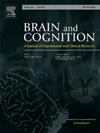机械知识和语义知识是对物理世界内隐理解的中介。
IF 1.4
3区 心理学
Q3 NEUROSCIENCES
引用次数: 0
摘要
最近的研究强调了对物理世界的内隐理解中认知的两个方面的重要性:语义知识(识别、分类和关联概念的能力)和机械知识(理解事物如何机械工作的能力)。然而,人类大脑如何整合这些认知过程在很大程度上仍未被探索。在这里,我们使用功能磁共振成像来研究这种整合,采用了一种新的自由观看任务。参与者观看描绘物体-工具对的图像,这些图像要么是机械一致的(例如,钉子-钢锤),要么是机械不一致的(例如,围巾-钢锤)。这些工具安装在桌子上的金属板上,与金属板接触的是一根剥去的电缆,可以插入或拔出电线,使工具带电或不带电。基于任务的功能连通性揭示了在机械动作和物理原理的处理过程中,特定左脑区域-中颞叶(MTG)、下额叶(IFG)和上边缘(SMG)回之间的相互作用,将这些区域的活动与机械知识(SMG)和物体相关语义知识(MTG)联系起来。值得注意的是,IFG在两种类型的处理过程中都很活跃,这表明该区域在多模式信息整合中起着关键作用。这些发现支持了最新的物理理解的综合神经认知模型,加深了我们对如何理解物理世界的理解。本文章由计算机程序翻译,如有差异,请以英文原文为准。
Mechanical and semantic knowledge mediate the implicit understanding of the physical world
Most recent accounts highlight the importance of two aspects of cognition in the implicit understanding of the physical world: semantic knowledge (the ability to recognize, categorize, and relate concepts) and mechanical knowledge (the capability to comprehend how things mechanically work). However, how the human brain may integrate these cognitive processes remains largely unexplored. Here, we use functional magnetic resonance imaging to investigate this integration employing a novel free-viewing task. Participants viewed images depicting object-tool pairs that were either mechanically consistent (e.g., nail – steel hammer) or mechanically inconsistent (e.g., scarf – steel hammer). These pairs were situated on a metal plate atop a table, with a stripped electrical cable in contact with the plate that could be plugged in or out from the electrical line, rendering the tools either electrified or not. Task-based functional connectivity revealed an interplay among specific left-brain regions – the middle temporal (MTG), inferior frontal (IFG), and supramarginal (SMG) gyri – during the processing of mechanical actions and physics principles, associating the activity of these areas with mechanical knowledge (SMG) and object-related semantic knowledge (MTG). Notably, the IFG was active during both types of processing, suggesting a critical role of this region in multi-modal information integration. These findings support the most recent integrated neurocognitive models of physical understanding, deepening our comprehension of how we make sense of the physical world.
求助全文
通过发布文献求助,成功后即可免费获取论文全文。
去求助
来源期刊

Brain and Cognition
医学-神经科学
CiteScore
4.60
自引率
0.00%
发文量
46
审稿时长
6 months
期刊介绍:
Brain and Cognition is a forum for the integration of the neurosciences and cognitive sciences. B&C publishes peer-reviewed research articles, theoretical papers, case histories that address important theoretical issues, and historical articles into the interaction between cognitive function and brain processes. The focus is on rigorous studies of an empirical or theoretical nature and which make an original contribution to our knowledge about the involvement of the nervous system in cognition. Coverage includes, but is not limited to memory, learning, emotion, perception, movement, music or praxis in relationship to brain structure or function. Published articles will typically address issues relating some aspect of cognitive function to its neurological substrates with clear theoretical import, formulating new hypotheses or refuting previously established hypotheses. Clinical papers are welcome if they raise issues of theoretical importance or concern and shed light on the interaction between brain function and cognitive function. We welcome review articles that clearly contribute a new perspective or integration, beyond summarizing the literature in the field; authors of review articles should make explicit where the contribution lies. We also welcome proposals for special issues on aspects of the relation between cognition and the structure and function of the nervous system. Such proposals can be made directly to the Editor-in-Chief from individuals interested in being guest editors for such collections.
 求助内容:
求助内容: 应助结果提醒方式:
应助结果提醒方式:


